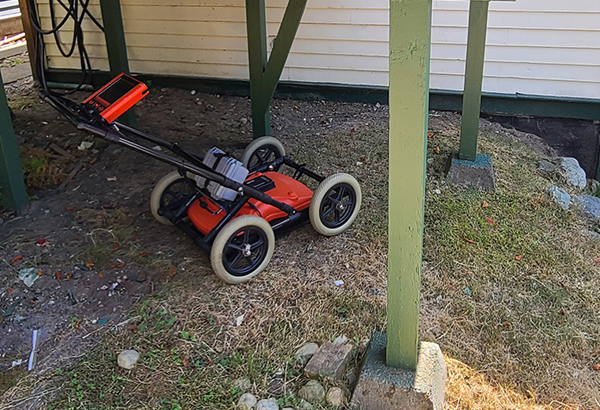 Fully Licensed and Insured
Fully Licensed and Insured Request an Oil Tank Scan
Request an Oil Tank Scan Request a Free Estimate
Request a Free Estimate

Ground-penetrating radar (GPR) is a geophysical method that uses electromagnetic waves to show images below the earth’s surface. This technology works by transmitting high-frequency radio waves into the ground and measuring the reflections that bounce back from buried objects and structures. These reflections are then processed and analyzed, allowing us to use the technology to see what is beneath the earth without expensive and intrusive digging. GPR is a special system because it provides us with information that is both non-invasive and incredibly accurate.
GPR has so many uses and is a valuable tool in our modern society. GPR is used for detecting objects that are hidden such as metals, clay, plastic, concrete, and other natural materials. This system also works to locate elements like air pockets, utility pipes, bedrock, and changes in depths. Here are a few examples of where GPR is used:
Ground penetrating radar offers several benefits over other methods of surface exploration such as drilling or excavation. The system itself is a model made up of a single piece of equipment that can detect images under large surface areas. Because of this and other advancements, GPR is both safe and cost-effective. It requires fewer resources and less time than drilling or excavation, helping to reduce the overall costs of a project. Another benefit of GPR is that it’s a non-invasive method of image detection. This reduces the environmental impact of exploration and minimizes the disruption to our communities land and structures. Harmful chemicals and hazardous materials are not used in GPR methods. Data provided by this type of technology is delivered fast to the user, making it a helpful tool in urgent law enforcement and forensic cases.
The basic setup of a ground-penetrating radar system consists of a transmitter and a receiver, which are used to send and receive electromagnetic waves into the ground. The waves bounce back when they encounter materials below the surface and these reflections are detected by the receiver. By analyzing the reflections, GPR systems create images for application users who are seeking more information about specific surface areas.
The number one method for locating buried oil tanks on residential or commercial properties is GPR. The system can identify anomalies that could indicate the presence of a buried oil tank, such as changes in the surface material or the presence of a metal object. Professional tank recovery companies will utilize GPR systems when assisting clients who require oil tank removal. The first step is to survey the area where the oil tank is suspected to be located- once the GPR survey is complete, the data is analyzed and used to assist in the removal of an oil tank with accuracy and efficiency.
With advances in technology and increased use, GPR is becoming an increasingly valuable tool for non-destructive testing and surface imaging. West Coast Tank Recovery proudly provides in-house GPR scanning equipment and technicians for those who require underground image location services. WC Tank Recovery serves in Vancouver, North Vancouver, Burnaby, New Westminster, Surrey, and Coquitlam. With over 17 years of experience, we are experts in providing professional oil tank detection and removal for both residential and commercial clients. Contact us today for a competitive quote!